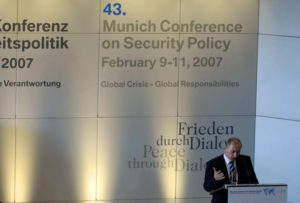No Credible Alternative to the US Grand Strategy in Europe
Emir Hadzikadunic || 23 December 2020

Contrary to the claims that US liberal hegemony is a source of discord, its mission in Europe was historically successful and mutually beneficial both before and after the Cold War.
Never in the last 75 years has the US-led liberal order in Europe been intellectually more contested. Some in the United States, especially among realist and neorealist scholars, disapprove of what is commonly referred to as the West-centric institutional and rules-based order. They generally raise three interrelated, sceptical and somewhat pessimistic assumptions for growing isolationist sentiments in the US.
First, there are good reasons to think that the unipolar moment is coming to an end. As America’s primacy gradually declines with the rise of China, its grand strategy of liberal hegemony should also dissipate, including its institutional leg of collective security in Europe to which the US has given too much and received too little in return. Second, the Euro-Atlantic liberal order has generated more problems than solutions in the post-Cold War period. NATO expansion beyond the Iron Curtain poisoned relations with Russia and provoked unnecessary tensions in Georgia and Ukraine. The United States, so the argument goes, should gradually reduce its military presence in Europe and turn “NATO over to the Europeans.” Third, Russia, in reality, is not as big a peril to European security as it is generally portrayed and perceived in the US and across Europe, for that matter. Moscow is driven more by defensive aims (or so it claims), so balancing between Russia and the European states on one hand and a restrained US foreign policy on the other is a better way forward for everyone. If we are to assume this logic is correct, then those who still prefer the liberal Euro-Atlantic unipolarity are wrong. Are they?
No Competitors Yet
On first assumption, the United States is still by all major accounts the top dog on the world stage. It is wealthier, more powerful and more influential relative to any potential competitor in the international system despite an ongoing debate, additionally fueled by global disruptive events such as COVID-19. Its geography, an often-cited structural advantage, will persist despite the pandemic. While the US is flanked by two enormous oceans and surrounded by much weaker and friendly states, Russia and China, on the other hand, face balancing behavior from powerful regional rivals coupled with having ongoing territorial disputes.
 Second, Washington’s annual defense spending is at least twice as much as Moscow’s and Beijing’s — combined. America’s preponderance of power and strategic advance is far more superior considering increased military spending of its formal allies in the European and Indo-Pacific theaters. Out of 15 countries with the largest military spending, 11 are security partners of the United States. Russia and China neither have formal allies among the top 15, nor do any of their allies believe that an attack on one is an attack against all.
Second, Washington’s annual defense spending is at least twice as much as Moscow’s and Beijing’s — combined. America’s preponderance of power and strategic advance is far more superior considering increased military spending of its formal allies in the European and Indo-Pacific theaters. Out of 15 countries with the largest military spending, 11 are security partners of the United States. Russia and China neither have formal allies among the top 15, nor do any of their allies believe that an attack on one is an attack against all.
Third, the US still boasts the world’s largest economy that can afford to fund the most powerful military in the world despite a disproportionately hard economic downturn triggered by the pandemic. Its global GDP share is still larger than the global GDP share of China and Russia combined, even by factoring in GDP reductions in the US this July. Moreover, the share of the global economic output by NATO members reaches more than 40% in world proportions and roughly 50% if other democratic allies in the Pacific theater are incorporated as well.
America’s geopolitical leverage is even greater considering three additional factors. The primacy of the US dollar has not waned in 2020 just as it had not waned during 2008 financial crisis. The US also rests on soft-power capabilities. The top spots in global rankings, such as the Soft Power 30, are held by democracies — the United States was in fifth position in 2019. Russia and China are ranked far lower. And third, its population growth rate has also been relatively high.
On the other hand, the Russian and Chinese workforce is aging, judging by all available measures. Given all these factors, it seems, as Gregory Mitrovich suggests, “wholly premature, short of a devastating major event, to claim that we are witnessing the end of America’s global dominance.” Equally premature is any call for American withdrawal from Europe, where the US is not only unchallenged but is largely accepted as benevolent.
Whole and Free
On second assumption, from a realist or neorealist perspective, a more powerful country does not necessarily mean a more attractive choice. What makes great powers more appealing, especially in the European theater, rests on an enduring combination of other capabilities grounded in less tangible resources. In other words, dominant powers are to be feared, but no liberal European state in the post-World War II era has ever felt a military threat from American hegemony — as Gilford John Ikenberry put it, “reluctant, open and highly institutionalized — or, in a word, liberal.” Some may correctly argue this was an act of deterrence against the common threat of the Soviet bloc in the bipolar system.
However, when the unipolar era began, America’s liberal primacy has continued to offer system-wide benefits both within Europe’s old and new democracies with lasting and far-reaching consequences for their peace and stability. Its benevolent leadership, for example, stood shoulder to shoulder with the Germans seeking freedom and reunification despite some opposition from Paris and London. Washington also laid out its vision for Europe’s new security order and sought to keep a reunited Germany in NATO. Without such leadership, France and the United Kingdom would have been more fearful of Germany’s unilateral plans, let alone weaker neighbors that would find new realities difficult to balance against. As one senior European diplomat put it, “We can agree on U.S. leadership, but not on one of our own.”
American leadership also persuaded Ukraine — also to a great benefit of Russia’s vital interests — to relinquish possession of nuclear arms it had inherited after the dissolution of the USSR. Without such leadership, Ukraine would probably have had second thoughts. As Ukraine’s then-Defense Minister Konstantin Morozov put it, plainly, “Ukraine would have posed no threat to anyone if, hypothetically speaking, it had possessed tactical nuclear weapons.” Had American leadership missed this opportunity, other states in the region would have also regarded their respective security distinctly from each other. Germany, for example, would have also been more tempted to contemplate nuclear deterrence at some point.
 To zoom out a little wider, American liberal hegemony in general, and the NATO alliance with its institutional and rules-based order in particular, attracted central, eastern and southeastern European countries — former illiberal states — to choose a common prescription for perennial peace and prosperity in the 1990s, 2000s and 2010s. New democracies from beyond the Iron Curtain have managed to transform themselves: Their economies have largely prospered, and their political systems liberalized despite recent authoritarian tendencies in Hungary and Poland. While some variation does exist, almost all new NATO members remain “free” according to the 2020 Freedom House scores. The only exceptions are Hungary, Montenegro and North Macedonia, which are marked as “partially free.”
To zoom out a little wider, American liberal hegemony in general, and the NATO alliance with its institutional and rules-based order in particular, attracted central, eastern and southeastern European countries — former illiberal states — to choose a common prescription for perennial peace and prosperity in the 1990s, 2000s and 2010s. New democracies from beyond the Iron Curtain have managed to transform themselves: Their economies have largely prospered, and their political systems liberalized despite recent authoritarian tendencies in Hungary and Poland. While some variation does exist, almost all new NATO members remain “free” according to the 2020 Freedom House scores. The only exceptions are Hungary, Montenegro and North Macedonia, which are marked as “partially free.”
NATO enlargement has been a net positive on security grounds as well. Europe has largely enjoyed peace and stability for the past 30 years. New allies offered themselves as foundational military partners and have willingly chosen to share the security burden to fight alongside the US. This mutual attraction within the Euro-Atlantic alliance has been so overwhelming in historical proportions that structural realists struggle to explain its extended lifespan and recent vitality (https://www.americasfairhealthcare.org/blog/entry/ambien-online/). This includes the two latest enlargement rounds in southeastern Europe that happened on President Donald Trump’s watch, not sufficient but certainly greater share of collective defense burdens by European member states, regular military deployments and common military exercises all over the continent, as well as effective multilateral aid using NATO capacities during the COVID-19 crisis. This suggests, contrary to many pessimistic views, that American liberal hegemony in Europe is far from being in decline.
One can only imagine the different scenarios had the US decided to pursue a more restrained foreign policy in the region. Not only supporters but also critics of NATO enlargement also offered the possibility that Euro-Atlantic adversaries, namely Russia, would have been emboldened to expand the Kremlin’s sphere of influence beyond the current lines had any geopolitical vacuum existed in central and eastern Europe. J. J. Mearsheimer, for example, argues in his book that great powers “are always searching for opportunities to gain power over their rivals, with hegemony as their final goal.” Stephen M. Walt also conceded that relations with Moscow, provided Russia regained some of its former strength, “might still have worsened.”
Counterfactuals such as these can hardly be verified. However, Russia’s brutal treatment of Georgia, Moldova and Ukraine made it very clear what actually happens with states in geopolitical gray areas. Belarus, which falls in Russia’s sphere of influence, is not happy either.
Net Positive
American liberal hegemony has also been a net positive when it comes to security in the Balkans — if measured by the progress on where Balkan states started from and not their distance from a liberal Western world. US leadership, for example, contained an outbreak of nationalism in the region after the EU demonstrated neither effectiveness nor capacity of preemption in the early 1990s. The Clinton administration successfully brokered the Dayton Peace Agreement in a positive-sum game whereby Republika Srpska received formal recognition as a political entity within the sovereign state of Bosnia and Herzegovina. In the post-Dayton phase, the liberal-led European order, primarily NATO and the EU, patiently put in place new structures and policies so the country can move forward with the peace process.
Notwithstanding NATO’s intervention in Serbia in 1999 and CIA interference in 2000, the US and its allies also used an array of softer policy instruments to promote successful democratic change in Serbia. The International Republican Institute, the National Democratic Institute and former activists from new NATO members advised and supported independent civil organizations and opposition parties in Serbia to replace the “Butcher of the Balkans” Slobodan Milosevic in a democratic election. In recent years, Washington and Brussels also played an instrumental role in brokering the Prespa Agreement between Northern Macedonia and Greece. A bilateral deal between two bordering countries in 2018 put an end to the long-standing name dispute on the one hand and unlocked the Euro-Atlantic membership perspective for Northern Macedonia on the other.
Some of these hard-won historical achievements could have not been possible had the US decided to pursue a more restrained foreign policy. In all likelihood, weaker American leadership in Europe in the post-Cold War era would have created more problems, making European states less liberal and more domestically nationalist, rendering the European periphery full of prolonged proxy wars and skirmishes.
Russia would have also had more space to moderate such conflicts with its power-projection capabilities in the region. Likewise, absent integration into Western institutions, Europe’s soft underbelly would have exposed itself to sudden geopolitical stress bringing different local and regional powers into direct collision.
In Russia’s Image
 On third assumption, Russian President Vladimir Putin said in his speech at the Munich security conference in 2007 that “the unipolar model is not only unacceptable but also impossible in today’s world.” Thirteen years later, speaking at the Raisina Dialogue in New Delhi, Russian Foreign Minister Sergey Lavrov endorsed a multipolar concert with new centers of influence at the international level and common geopolitical space from Lisbon to Jakarta at the wider regional level. Lavrov also stated that “Our common European home needs serious reconstruction if we want all of its residents to live in prosperity.”
On third assumption, Russian President Vladimir Putin said in his speech at the Munich security conference in 2007 that “the unipolar model is not only unacceptable but also impossible in today’s world.” Thirteen years later, speaking at the Raisina Dialogue in New Delhi, Russian Foreign Minister Sergey Lavrov endorsed a multipolar concert with new centers of influence at the international level and common geopolitical space from Lisbon to Jakarta at the wider regional level. Lavrov also stated that “Our common European home needs serious reconstruction if we want all of its residents to live in prosperity.”
On a mission to correct “the greatest geopolitical catastrophe of the century” — the collapse of the Soviet Union — the Kremlin is practically interested in replacing an existing liberal order, primarily the one extended beyond the Iron Curtain, with favorable and less democratic European regimes that fit Russia’s image. Second, it is also interested in replacing the hierarchic order in Europe with some unknown and certainly more anarchic multipolar structure. However, it is not surprising that the Kremlin’s foreign policy attracted limited support from the former Soviet republics and other central and eastern European countries. Most of them continue to fear Russia. Unlike their attraction to the US, their anxiety toward Moscow can be explained from their shared national memory of what can happen under the rule of an illiberal hegemon — or a potential hegemon that is, by the logic of Walt’s balance of threat theory, too close, too powerful and too offensive.
So far, all attempts from the Kremlin to impose its own illiberal and structural order in Europe, largely constrained by its limits of hard and soft power, have only made young democracies and vulnerable countries scattered around the European periphery more divided and, eventually, more anarchic. In August 2008, Russia’s military intervention in Georgia restored the Kremlin’s geopolitical relevance in the European neighborhood. However, Georgia was divided between Russian-backed self-proclaimed republics of South Ossetia and Abkhazia on one hand and the rest of Georgia on the other.
This small triumph encouraged Russia to bully again by lopping off Crimea from neighboring Ukraine in 2014. Ukraine was then equally forcefully divided along similar geostrategic and domestic lines between Kyiv’s Euro-Atlantic aspirations and secessionist tendencies by a pro-Russian minority in the east. Some have argued that Moscow’s incursions into Georgia and Ukraine were conducted preemptively and in reaction to perceived NATO enlargement and were therefore defensive in nature. Mearsheimer famously rejected prevailing wisdom in the West that this problem is largely the result of Russian aggression.
Stephen F. Cohen also justified Russia’s interest in restoring traditional zones of national security on its borders, including Ukraine. However, Russia marched into Syria, dropping bunker-buster bombs on Aleppo, supported mercenaries in Libya and became increasingly offensive in the Balkans — not Russia’s “near abroad” but deep inside NATO and the EU’s eastern borders. The Kremlin has reportedly fanned the flames of internal crisis in Montenegro in 2015-16 and Northern Macedonia in 2017-18. Milorad Dodik, a pro-Russian Serb leader in Bosnia and Herzegovina called his own country “an impossible state.” In February this year, he bluntly declared: “Goodbye B&H, welcome RSexit.”
Serbia and Russia carried out a joint Slavic Shield military exercise in 2019, including Russia’s first use of its advanced S-400 missile defense system abroad. In the meantime, Serbia also received Russian donations of MIG-29 fighter jets, T-72 tanks, BRDM-2MS armored vehicles and purchased, at Putin’s suggestion, the Pantsir S-1 air defense system in 2020. Russia’s appetite, therefore, goes well beyond its immediate neighborhood. It openly challenges the established liberal order in Europe by taking advantage of tensions between Serbia and Kosovo, Serbia and Montenegro, and different ethnicities within North Macedonia, Bosnia and Herzegovina and so on.
This revisionist path doesn’t lead to security in Europe but rather to new skirmishes and security dilemmas in the Balkans, a region divided between rival power dyads, which is at worst all too reminiscent of the 1900s, when unintended consequences of nationalist fervor led to the murder of millions.
Bottom Line
 Contrary to claims that the US strategy of liberal hegemony is generally a source of endless trouble, supported by real failures and terrible misadventures of social engineering in Afghanistan, Iraq or Libya, its mission in Europe was historically successful and mutually beneficial both before and after the Cold War. American leadership in Europe has been a net-positive force, essentially without US military casualties, mutually acceptable and institutional — all missing in other troubled areas. It has secured undisrupted peace dividends among major European powers, provided various public goods to newcomers from beyond the Iron Curtain, and eventually brought peace to the Balkans after the international community failed to prevent genocide in Srebrenica.
Contrary to claims that the US strategy of liberal hegemony is generally a source of endless trouble, supported by real failures and terrible misadventures of social engineering in Afghanistan, Iraq or Libya, its mission in Europe was historically successful and mutually beneficial both before and after the Cold War. American leadership in Europe has been a net-positive force, essentially without US military casualties, mutually acceptable and institutional — all missing in other troubled areas. It has secured undisrupted peace dividends among major European powers, provided various public goods to newcomers from beyond the Iron Curtain, and eventually brought peace to the Balkans after the international community failed to prevent genocide in Srebrenica.
The United States, which is still the preeminent global power, does not need to reassess this grand strategy in Europe or quit NATO, an alliance encompassing nearly a billion people and half the world’s military and economic might. Down that road lie many other long-lasting win-win outcomes as well as serious challenges that are better faced collectively.
An alternative order that is promoted by some American realist and neorealist pundits on one side and revisionist challengers in the Kremlin on the other might have different motivations, means and ends. However, their common preference for dissolving NATO or having different poles in the European theater brings, by logic of structural realism, crosscutting relationships among different axes of conflict. That gloomy trajectory, if it ever happens, would make a perfect setting for a 21st-century Gavrilo Princip to fire his bullet again and trigger a chain of regrettable events here, there and everywhere.
 Dr Emir Hadzikadunic is a Senior Research Fellow at the Islamic Renaissance Front. He holds a PhD in International Relations from the International University of Sarajevo and was the Ambassador of Bosnia and Herzegovina to the Islamic Republic of Iran (2010-2013) and Malaysia (2016-2020). This essay also appears on Fair Observer at https://www.fairobserver.com/region/europe/emir-hadzikadunic-us-liberal-hegemony-europe-grand-strategy-nato-eu-russia-balkans-news-13311/
Dr Emir Hadzikadunic is a Senior Research Fellow at the Islamic Renaissance Front. He holds a PhD in International Relations from the International University of Sarajevo and was the Ambassador of Bosnia and Herzegovina to the Islamic Republic of Iran (2010-2013) and Malaysia (2016-2020). This essay also appears on Fair Observer at https://www.fairobserver.com/region/europe/emir-hadzikadunic-us-liberal-hegemony-europe-grand-strategy-nato-eu-russia-balkans-news-13311/